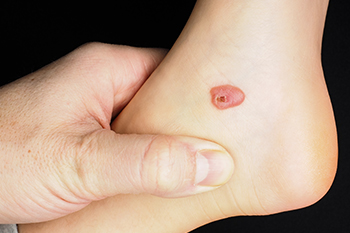
Blood blisters on the foot, though small in size, can cause significant discomfort and concern. These blisters form when blood vessels near the skin's surface rupture due to friction or trauma, trapping blood beneath the skin's layers. Common causes include wearing ill-fitting shoes, repetitive rubbing or pressure, and sudden impacts or injuries. Blood blisters typically appear as raised, fluid-filled sacs with a red or dark appearance due to the presence of blood. While they may resolve on their own over time, treatment options can alleviate pain and promote healing. It is essential to avoid popping or puncturing the blister, as this can increase the risk of infection. Instead, gently clean the area with mild soap and water, apply a sterile bandage or blister pad to protect the blister, and allow it to heal naturally. With proper care and attention, blood blisters on the foot can heal effectively, restoring comfort and mobility. If the blister is painful or shows signs of infection, it is suggested that you consult a chiropodist for further evaluation and management.
Blisters can usually be treated at home, however, if you have recurring blisters or experience significant discomfort or pain, please consult with Paul A. Scotti, D.Ch from West Toronto Foot & Ankle Clinic Inc. . Our chiropodist will assess your condition and provide you with quality foot and ankle treatment.
What Is a Blister?
A blister is a small pocket of fluid in the upper skin layers and is one of the body’s natural responses to injury or pressure. Blisters can also result from burns, fungal or viral skin infections, and the feet are particularly prone due to ill-fitting footwear and friction. Friction on the skin causes the upper layer of skin to separate from the lower layers. The space that this separation creates then becomes filled with a liquid called serum, which protects the lower layers of skin.
Treatment
If you notice a blister on your foot, you can cover it with a soft bandage or dressing to protect it. Popping the blister is discouraged. Doing so exposes the raw skin underneath it to bacteria and also raises the risk of infection. If a blister pops naturally, let it drain before covering it with a bandage. Blisters usually heal on their own or with home treatment, however, if your blister is recurring, very painful, or appears infected, it is recommended that you see a chiropodist for treatment.
Prevention
You can help to prevent blisters by wearing comfortable, well-fitted shoes. Keep your feet dry by wearing moisture-wicking socks and dust your feet with talcum powder if they tend to get sweaty. If you have areas on your feet that are more susceptible to blisters, you might be able to prevent the blister from forming by covering it with a pad.
If you have any questions, please feel free to contact our office located in . We offer the newest diagnostic and treatment technologies for all your foot care needs.
